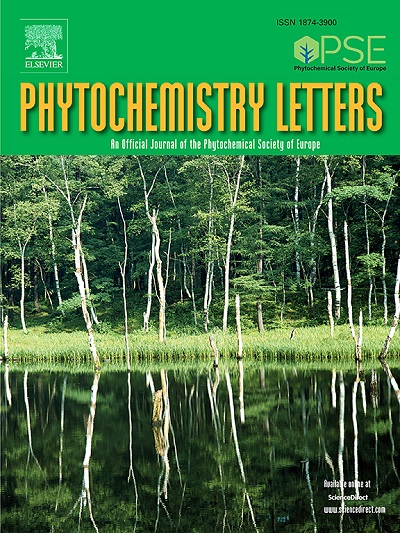双异构体树脂苷的研究
IF 1.4
4区 生物学
Q4 CHEMISTRY, MEDICINAL
引用次数: 0
摘要
卷花属卷花科,广泛分布于广东、广西、云南等地。传统上,它被用于医学目的,如止血和促进组织再生。本研究旨在研究牡茅的化学成分,并预测其化学成分与6NJS蛋白的结合亲和力。从该植物的地上部分分离到四种新的树脂苷,命名为argyreia R-U(1-4),以及已知化合物(5-9)。化合物1-4的糖苷酸为operculinic酸C(10)。化合物1和3以及化合物2和4是同分异构体,两对异构体之间的差异归因于一个取代基和内酯化位点的变化。通过1D和2D NMR、HR-TOF-MS、UV和IR光谱对化合物的结构进行了表征。分子对接结果表明,化合物1-4和10成功定位于蛋白复合物(PDB ID: 6NJS)的结合袋内,预测与6NJS蛋白具有中等亲和力。本文章由计算机程序翻译,如有差异,请以英文原文为准。
Two pairs of isomeric resin glycosides from Argyreia obtusifolia
Argyreia obtusifolia is widely distributed in Guangdong, Guangxi, and Yunnan provinces of China and belongs to the Convolvulaceae family. It has been traditionally used for medicinal purposes, such as stopping bleeding and promoting tissue regeneration. The present study was designed to investigate the chemical composition of A. obtusifolia and predict the binding affinity between its chemical constituents and the 6NJS protein. Four new resin glycosides, named argyreia R-U (1-4), along with known compounds (5-9), were isolated from the aerial parts of the plant. The glycoside acid of compounds 1-4 is operculinic acid C (10). Compounds 1 and 3, as well as compounds 2 and 4 are isomers, with the differences between the two pairs of isomers attributed to variations in one substituent and the site of lactonisation. The structures of these compounds were elucidated using 1D and 2D NMR spectroscopy, HR-TOF-MS, and UV and IR spectra. Molecular docking results indicated that compounds 1-4 and 10 were successfully localised within the binding pocket of the protein complex (PDB ID: 6NJS), predicting moderate affinity for the 6NJS protein.
求助全文
通过发布文献求助,成功后即可免费获取论文全文。
去求助
来源期刊

Phytochemistry Letters
生物-生化与分子生物学
CiteScore
3.00
自引率
11.80%
发文量
190
审稿时长
34 days
期刊介绍:
Phytochemistry Letters invites rapid communications on all aspects of natural product research including:
• Structural elucidation of natural products
• Analytical evaluation of herbal medicines
• Clinical efficacy, safety and pharmacovigilance of herbal medicines
• Natural product biosynthesis
• Natural product synthesis and chemical modification
• Natural product metabolism
• Chemical ecology
• Biotechnology
• Bioassay-guided isolation
• Pharmacognosy
• Pharmacology of natural products
• Metabolomics
• Ethnobotany and traditional usage
• Genetics of natural products
Manuscripts that detail the isolation of just one new compound are not substantial enough to be sent out of review and are out of scope. Furthermore, where pharmacology has been performed on one new compound to increase the amount of novel data, the pharmacology must be substantial and/or related to the medicinal use of the producing organism.
 求助内容:
求助内容: 应助结果提醒方式:
应助结果提醒方式:


